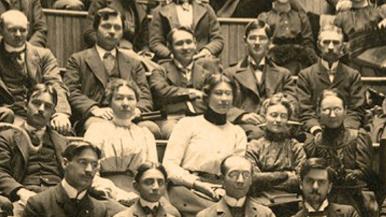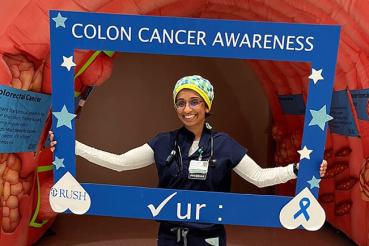The number of women doctors at RUSH today is an extraordinary shift from 1903, when the Rush Medical College graduated its first class that included women — eight in all, compared to 250 men.
Since March is Women’s History Month, I wanted to share some of the history of the first women doctors to practice at Rush and to graduate from Rush Medical College.
I’ll begin with a little historical background of the time when these women came to Rush and the circumstances surrounding them. Then we’ll look at four women doctors — two of the first women to graduate from Rush Medical College; the college’s first woman faculty member; and the first woman staff member at Presbyterian Hospital, one of the predecessors of Rush University Medical Center.
Late 1800s brought women to workforce, medicine
The arrival of women doctors at Rush followed the migration of families from rural to urban areas in the late 1800s, which was fueled by the Industrial Revolution. This change exposed women to more and different work opportunities, and from 1880 to 1910, the female work force in this country increased 1,000%.
By the turn of the century, the number of women in higher education also had increased dramatically. Many schools became coeducational to accommodate this desire. In 1870, 21% of all students enrolled in college were women. Forty years later in 1910, that number jumped to 40%.
Similarly, medical schools increasingly accepted women students, who previously had been forced to segregate themselves and open women’s medical schools. By 1870, there were about 550 trained women doctors in the country. By 1900, there were more than 7,000.
After graduation, many women faced struggles due to their sex. Many male physicians did not want to hire women, and most male patients would not be seen by a woman. As a result, most women doctors' patients were women and children, and many worked in obstetrics and gynecology. The American Medical Association did not accept female members formally until 1915.
Effa V. Davis, MD: Champion of mothers and children
Effa V. Davis, MD, worked at the Chicago Maternity Hospital and Training School for Nurses from its opening in 1894 and became its owner in 1904.
She taught at Northwestern’s Woman’s Medical School and at the College of Physicians and Surgeons. She was appointed demonstrator of obstetrics at Rush Medical College in 1898, becoming its first female faculty member.
Davis’ goal was to teach young mothers, particularly unmarried mothers, to care for their babies and keep these mothers and babies together. She also believed an obstetrician’s job didn’t end at childbirth. She thought an obstetrician should support breastfeeding and infant care.
She spoke openly about abortion, engaging in a discussion in 1910 with other physicians and a lawyer on the criminality of abortion. She believed in open discussion of abortion and educating the public. Part of the problem, she believed, was how illegitimate children were treated by society. She believed if this stigma were lifted, women wouldn’t seek abortions.
Caroline Hedger, MD: Advocate for immigrants and poor
Caroline Hedger, MD, who graduated from Rush Medical College in 1904, practiced internal medicine for most of her life. She specialized in working with immigrant families and the poor. Hedger believed that social issues could be solved through the intervention of legal, education, and social welfare institutions.
In 1906, Hedger wrote “Tuberculosis in Packingtown” after recognizing a higher rate of tuberculosis among residents near the stockyards. Her article exposed unhealthy living and working conditions, pollution and overcrowding at the same time as Upton Sinclair’s The Jungle exposed these problems to the greater population.
Hedger believed an increase of wages and lowering of rent would allow people to have more bedrooms and alleviate overcrowding. She found a correlation between long, irregular work hours and poor diet, limited diversions, and more alcohol consumption.
From 1920 to the 1940s, she was a medical consultant for the Elizabeth McCormick Memorial Fund, promoting child health with a holistic approach. She developed the Parent’s Score Card, which rated aspects of child health and parenting techniques.
Ruth Tunnicliff, MD: Infectious diseases researcher
Ruth Tunnicliff, MD, graduated from Rush in 1903 — in Rush’s first class including women graduates. She graduated with eight women and 250 men.
Upon her graduation, Tunnicliff joined Chicago’s John McCormick Institute for Infectious Diseases (later known as the Hektoen Institute) and worked with famed bacteriologist Ludvig Hektoen, MD, pathology professor at both Rush and the University of Illinois at Chicago. She stayed in that capacity for almost 40 years. She was one of the few women engaged in medical research during the early years of the century.
Tunnicliff published more than 100 papers and notes. She contributed to the understanding of diphtheria, scarlet fever and measles.
During World War I, she served as an army contract surgeon, performing clinical lab work.
In the 1930s, Tunnicliff began working for the Foundation for Dental Research, at the School of Dentistry of Loyola University, 1934-1940, focusing on tooth decay.
Isabella Coler Herb, MD: Leader in anesthesiology
Isabella Coler Herb graduated from Northwestern University’s Woman’s Medical School in 1892 and performed her internship at Mary Thompson Hospital. She then was welcomed by the Mayo Clinic in Rochester, Minnesota, as its first “physician anesthetist.”
Up until then, Mayo had used junior surgical residents or nurses trained in ether and chloroform. It was a time when surgical operations were few and far between, so a full-time anesthesiologist on a hospital’s staff often didn’t seem worth the cost.
Herb was invited by Arthur Dean Bevan, MD, then head of Rush’s surgery department, to take charge of the Department of Anesthesiology at Rush Medical College and Presbyterian Hospital (which the college established in 1883 to provide clinical training opportunities for students). She served as their chief anesthetist from 1909 to 1941, becoming the first woman appointed to the staff of Presbyterian Hospital.
Only licensed physicians could prescribe drugs and perform operations, and yet no training was required to administer anesthesia. Herb believed a physician anesthetist should be involved in every surgery and that a surgeon’s only responsibility regarding anesthetic was in choosing a competent physician to administer it.
She was also involved in equipment design and modification, such as shown in the accompanying photo. She assisted Lawrence H. Prince, MD, in developing the open drop method of ether administration, which was easier for patients and reduced toxic after-effects. Herb also was the first to administer ethylene gas during surgery, which Bevan performed in 1923.
Upon her retirement, Rush’s entire anesthesiology department was female. It was considered the best department in the country for the teaching of anesthesiology.




